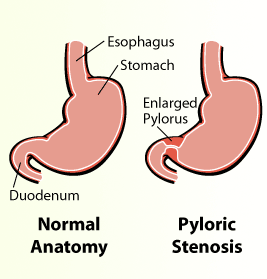Pyloric Stenosis
 Pyloric stenosis, also called infantile hypertrophic pyloric stenosis, is a condition caused by an enlarged pylorus. The pylorus is a muscle that opens and closes to allow food to pass through the stomach into the intestine. When this muscle becomes enlarged, feedings are blocked from emptying out of the stomach. The retained feedings cause the infant to vomit.
Pyloric stenosis, also called infantile hypertrophic pyloric stenosis, is a condition caused by an enlarged pylorus. The pylorus is a muscle that opens and closes to allow food to pass through the stomach into the intestine. When this muscle becomes enlarged, feedings are blocked from emptying out of the stomach. The retained feedings cause the infant to vomit.
What causes pyloric stenosis?
There is no known reason for enlargement of the pylorus. The main symptom of pyloric stenosis is vomiting undigested breast milk or formula soon after a feeding. Vomiting usually begins at four weeks of age but can happen as early as two weeks after birth. Once vomiting begins it becomes more frequent, and severe, and is often described as "forceful" or "projectile". Infants with pyloric stenosis may become fussy and, since they cannot keep down all their feedings, are hungry between feedings and are not able to gain weight normally. If the vomiting continues infants may become ill from dehydration.
Pyloric stenosis is one of the most common conditions requiring surgery in infants. It is more common in boys than girls and usually affects children who are born at full term. It rarely occurs in premature infants. Although not thought to be hereditary, pyloric stenosis occurs more commonly in children of parents who had pyloric stenosis themselves as infants
How is pyloric stenosis diagnosed?
An examination of the abdomen may allow the doctor to feel the enlarged pyloric muscle (called an "olive"). If the pylorus cannot be felt, pyloric stenosis can be diagnosed by ultrasound study or by x-rays taken after the infant drinks a liquid called "contrast." This is a study which examines the stomach and small intestine and is called an upper GI.
How is pyloric stenosis treated?
Pyloric stenosis does not get better by itself and must be corrected with an operation. The operation is called a "pyloromyotomy" where the surgeon cuts through the muscle fibers of enlarged pyloric muscle in order to widen the opening into the intestine. Prior to the operation, your child will be admitted to the hospital for intravenous fluids. Feedings will be held temporarily and restarted after the operation. A blood sample will be taken to check for dehydration and electrolyte abnormalities. Electrolytes measure the amount of sodium, potassium, carbon dioxide and chloride in the blood. The surgeon will schedule the operation as soon as the infant's electrolyte levels are normal and the dehydration is corrected. This may take a day of treatment with intravenous fluids. A pyloromyotomy can be done using a small telescope and two miniature instruments through several small bandaid sized incisions, or it can be done through a very small incision on the abdomen. The operation usually takes about an hour.
In most pyloromyotomy operations, there is very little blood loss. You child will receive blood only in the rare case of an extreme emergency.
How long will my child be in the hospital?
Most infants are discharged from the hospital one to two days after the operation.
